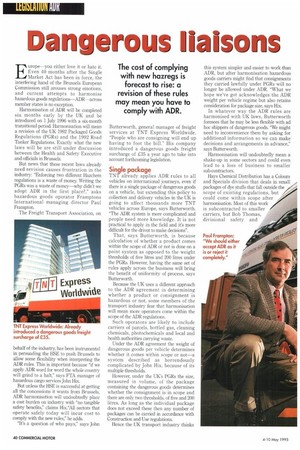TNT already applies ADR rules to all vehicles on international
Page 52

Page 53

If you've noticed an error in this article please click here to report it so we can fix it.
journeys, even if there is a single package of dangerous goods on a vehicle, but extending this policy to collection and delivery vehicles in the UK is going to affect thousands more TNT vehicles across Europe, says Butterworth. "The ADR system is more complicated and people need more knowledge. It is not practical to apply in the field and it's more difficult for the driver to make decisions".
That, says Butterworth, is because calculation of whether a product comes within the scope of ADR or not is done on a point system as opposed to the weight thresholds of five litres and 200 litres under the PGRs. However, having the same set of rules apply across the business will bring the benefit of uniformity of process, says Butterworth.
Because the UK uses a different approach to the ADR agreement in determining whether a product or consignment is hazardous or not, some members of the transport industry fear that harmonisation will mean more operators come within the scope of the ADR regulations.
Such operators are likely to include carriers of parcels, bottled gas, cleaning chemicals, photochemicals and local and health authorities carrying waste.
Under the ADR agreement the weight of dangerous goods per vehicle determines whether it comes within scope or not—a system described as horrendously complicated by John Hix, because of its multiple thresholds.
However, under the UK's PGRs the size, measured in volume, of the package containing the dangerous goods determines whether the consignment is in scope and there are only two thresholds, of five and 200 litres. As long as the individual package does not exceed these then any number of packages can be carried in accordance with Construction and Use regulations.
Hence the UK transport industry thinks this system simpler and easier to work than ADR, but after harmonisation hazardous goods carriers might find that consignments they carried lawfully under PGRs will no longer be allowed under ADR. "What we hope we've got acknowledges the ADR weight per vehicle regime but also retains consideration for package size, says Hix.
In whatever way the ADR rules are harmonised with UK laws, Butterworth foresees that he may be less flexible with ad hoc shippers of dangerous goods. "We might need to inconvenience them by asking for additional information so we can make decisions and arrangements in advance," says Butterworth.
Harmonisation will undoubtedly mean a shake-up in some sectors and could even lead to a loss of business to smaller sub-contractors.
Hays Chemical Distribution has a Colours and Specials division that deals in small , packages of dye stuffs that fall outside the scope of existing regulations, but could come within scope after harmonisation. Most of this work is subcontracted to smaller carriers, but Bob Thomas, divisional safety and
training manager says "we may have to take more of that in-house if we see parcel carriers less and less keen to take on board small packages. It's an option we have."
Significant costs
There are still 16 contentious areas to the harmonisation process, some of which involve significant costs for operators, says Hix. One example is the re-placarding of tankers. For tankers carrying a mix of oil products under ADR regulations, each compartment would have to be placarded separately and then re-placarded when its contents were changed.
The FTA is pressing for a system similar to the display of the "1270" placard which is current UK law.
ADR regulations also stipulate a tool kit, two amber lights and a wheel chock, a requirement dismissed as "rubbish" by Hix. "That sort of equipment may have been relevant in 1957 when ADR was first devised and vehicles were making long international journeys but developments in vehicle technology render this equipment useless," he adds.
Another fear expressed by Hix is that if the new rules are too onerous they may not be followed: "There will be a temptation for carriers to peel labels off and consign packages incorrectly or not declare consignments as dangerous goods."
A consultation document is expected to be published next month after which tM HSE will return to Brussels towards the end of the year to seek final agreement with Brussels.
While negotiations continue about exactly how ADR is adopted into UK law, Paul Frampton echoes a plea that must be close to many an operators' heart: "Europe should be working to one set of rules. It is about time the Government decided a policy on Europe so we know where we are. Under these circumstances we should either accept ADR as it is or reject it completely".
n by Nicky Clarke
















































































































